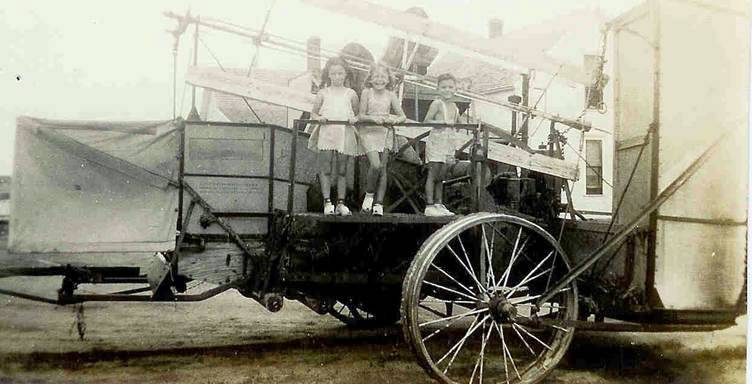|
Moderated by NW Okie! |
Volume 8 , Issue 72006Weekly eZine: (374 subscribers)Subscribe | Unsubscribe Using Desktop... |
Threshing & Combining...

by - Charles Cook, Louisiana Bayou
There is an old saying. 'If Mohamed can't come to the mountain, bring the mountain to Mohamed.' Without cartoons, I might add.
 Threshing was moving the mountain. The grain stalks were cut and hauled to a stationary machine that separated the grain from the stalk, and deposited the remains into what would more accurately be called a straw pile, which had little value as fodder for animals. Born in 1937, I can remember the straw piles, but the threshing machine was replaced by the combine during the 1930's.
Threshing was moving the mountain. The grain stalks were cut and hauled to a stationary machine that separated the grain from the stalk, and deposited the remains into what would more accurately be called a straw pile, which had little value as fodder for animals. Born in 1937, I can remember the straw piles, but the threshing machine was replaced by the combine during the 1930's.
The threshing machine had no power. That was supplied by a long belt that ran from a flywheel on a tractor to the threshing unit. The long belt was so the tractor unit could be placed away from the thresher and its potential powder keg of dry straw and grain dust generated. This reduced the fire hazard. The earliest tractor units were powered by steam, with an actual flame producing the power by generating steam in a boiler, which in turn supplied the pressure to run the steam engine.
By comparison, modern self propelled combines get the job done in an amazingly short time. Instead of having a harvest crew working on the place for a week, the job is often done by custom combiners and if the farm owner is paying attention, they move in and are finished so quickly they might be done before the owner knows they are there. Another amazing thing is that these modern combines cost more than our grandfathers paid for their farms.
I'm submitting two photos of a threshing operation of my great-great grandfather Joseph Barnett in Woods County, Oklahoma, whose log home we have been discussing on this web site. Note the long belt mentioned above. This shows a steam tractor, as compared to the petroleum based fuel engine on the tractor shown in last week's issue. I can't date this, but Joe Barnett died in 1922. I expect that it was at least a decade prior to that.
 The third photo is of an early tractor pulled combine owned by my grandfather, Earl Cook. It was taken in about 1941 in front of his farm house in Grant Count, Oklahoma. This is the house that had a cistern, which I wrote about previously. There was still a lot of canvas and wood used in its construction. I am the little boy standing on it. I was about four years old. The two girls were Patsy and Jeanette Wellman, my first cousins. The Wellmans were another old Grant County (Oklahoma) family.
The third photo is of an early tractor pulled combine owned by my grandfather, Earl Cook. It was taken in about 1941 in front of his farm house in Grant Count, Oklahoma. This is the house that had a cistern, which I wrote about previously. There was still a lot of canvas and wood used in its construction. I am the little boy standing on it. I was about four years old. The two girls were Patsy and Jeanette Wellman, my first cousins. The Wellmans were another old Grant County (Oklahoma) family.
I lived in Louisiana, and they were living in San Diego, California. Harvest was later in the year then. I remember that the metal on the combine was so hot it would blister bare skin. Unlike with today's combines with air conditioned cabs, it was still terrible hot, dirty, sticky work.
| View or Add Comments (0 Comments)
| Receive
updates ( subscribers) |
Unsubscribe
| © . Linda Mcgill Wagner - began © 1999 Contact Me | |
